Introduction
The Record has been a home for heraldry since its first publication in 1870. The first issue contained an explanation of the seal used by the Society, the very same seal which continues today to grace the cover of The Record.
Heraldry began in the feudal age when it was necessary for knights covered in armor to tell friend from foe on the battlefield. The practice arose among combatants to adorn their shields and surcoats with designs – called charges – which identified the bearer. These designs eventually became hereditary – passed down from father to sons. Therefore the original purpose of heraldry was identification.
Although centuries removed from those times, heralds in England, Scotland, Ireland, Canada, Belgium, and South Africa continue today to issue grants or registrations of arms which are substantive, officially recognized by the state.
The American Republic has never had an arms granting authority for individuals, although government departments and agencies, the military, and academic institutions have long used heraldry. The flags of New York, New Jersey, and Connecticut all have the state's full armorial achievements, as adopted by the legislatures. Since the founding of the colonies, settlers and their descendants bore the arms granted to their ancestors or assumed their own.
Presented here are fifteen color images of heraldry. Fourteen appeared in The Record between 1910 and 1920 and one in Collection of the New York Genealogical & Biographical Society, Vol. 1. Paul Campbell, a member of the Society's Heraldry Committee, discovered them while reviewing issues of The Record. He subsequently made special trips to the library to investigate them further. What distinguished them was the exceptional quality of the reproduction: they are in color and very clearly detailed, suggesting that the editor wanted to feature them prominently. Color reproduction at the time, while not unavailable, was nonetheless not common and was expensive. John Shannon, Chairman of the Society’s Heraldry Committee, investigated the authenticity of the arms in heraldic record books.
Here, we include all the images, summarize the articles, and provide whatever brief comment or conclusion that was made about the propriety of the use of any of the arms. We also include the description of the arms in heraldic language, called blazon. In many cases, a shield and crest are referred to as a “family” coat of arms. Technically, there is no such thing as family arms. A coat of arms is granted to an individual, the grantee, and is inherited by his descendants. The eldest or first son inherits the arms as used by his father, undifferenced; while the younger siblings difference the shield to with a mark of cadency. This practice is still enforced in Scotland; but hardly observed in England and Wales.
While we have the images on record, details about them remain unknown. Who the artists were remains a mystery. Color plates of this type being relative more expensive to produce, it is reasonable to believe that funding might have been solicited or offered to have them included. Well, why not?
While the artists involved were technically competent, the renderings suggest that they were heavily influenced by a style that prevailed in Europe in the late 19th century and that is now quite dated. Indeed, it is looked upon as a low point in the history of heraldic art. There are some stylistic aspects of these renderings – most conspicuously, the often unsatisfactory sense of proportion – that suggest the artists were unfamiliar with good or correct heraldry. Nevertheless, it is clear that the Society and the members at the time took heraldry very seriously. The Committee on Heraldry today is again energetically interested in promoting knowledge and appreciation of the subject and research on heraldry featured in The Record continues.
The Renderings
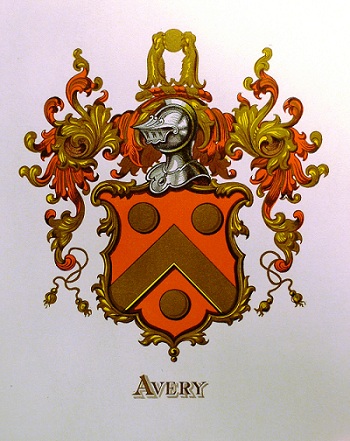 Avery
Avery
(of Huwish, Co. Somerset and Enfield, Co. Middlesex)
Coat of arms: “Gules (Red) a fess (sometimes a chevron) Or (Gold) between three bezants.”
Crest: “Two lions’ gambs Or (Gold) supporting a bezant.”
That “sometimes” in Burke’s General Armory is curious; heraldry is precise and the arms of one family must be unique. Samuel Putnam Avery writes in his article on the family that the fess is for the family in England, while the chevron is used by the American branch. The earliest known ancestor was Robert Avery, a yeoman from Somerset. William Avery brought a painting of the arms with him in 1650 when he came to the New World. Samuel Avery provided the painting, along with a silver seal with the arms, to the Dedham Historical Society in 1919. Some items in this rendering are typical of what is included in other renderings here. The helmet as drawn is more symbolic than based on anything real. The mantling appears to be made of metal rather than cloth. The border around the shield is a decorative touch, not part of the actual design.
Avery, Samuel Putnam. “Avery Registration of Pedigree.” The NYG&B Record, Vol. LI, No. 1 (January 1920): 84.
 Coles
Coles
(Parrocks Lodge, near Chard, co. Somerset)
Coat of arms: “Argent (Silver) a bull Gules (Red) within a bordure Sable (Black) bezantée."
Crest: “out of a ducal coronet Or (Gold) a demi dragon Vert (Green) holding an arrow of the first headed and feathered Or (Gold).”
Hopper Striker Mott, named after maternal surnames, submitted a pedigree listing his earliest American ancestor as Robert Coles (c. 1597-1654) who was living in Connecticut in 1630 and was Deputy in Roxbury in 1632. He was a Deputy in Roxbury in 1632.
The realistically drawn bull is stylistically wrong: it is small and delicate and seems lost in the field of the shield. The crest is more lively and better proportioned.
Mott, Hopper Striker. "Coles Register of Pedigree." The NYG&B Record, Vol. XLIII, No. 2 (April 1912): 197-8, with arms appearing later in Vol. XLV, No. 2 (April 1914): opposite 137.
 Cuyler
Cuyler
These are the arms of Hendrick Cuyler. They are recorded in William J. Hoffman's An Armory of American Families of Dutch Descent. The base Cuyler arms are "Vert (Green), an arrow in bend Or (Gold)."
Cuyler was a tailor by trade and became an Albany Alderman and militia officer of some repute. He differenced his arms with his initials, an unfortunate choice from a viewpoint of traditional heraldry (letters are not considered suitable charges) but one which provides sure confirmation of ownership.
Hoffman authored a number of articles on Dutch genealogy and heraldry in the early 20th century, recently reprinted in An Armorial of American Families of Dutch Descent, and he considered the genealogy done on this family to be among the best he had seen.
Cuyler is Dutch for archer or bowman, making these canting or punning arms, which contain a visual reference in the arms to the surname of the bearer. And, while there is a crest, there is no torse.
Nicoll, Maud Churchill. "The Earliest Cuylers in Holland and America." The NYG&B Record, Vol. XLII, No. 4 (October 1911): 351-369.
 Davenport
Davenport
(of Davenport, Co. Chester, descended from Ormus de davenport, temp.Conquest. The direct male line became extinct in 1677, when Davenport passed, with Elizabeth, elder daughter and co-heir of John Davenport, Esq., to Robert Davies, Esq., of Manley, whose heiress carried the estate to Sir Matthew Deane, Bart., but died d.s.p.)
Arms: “Argent a chevron between three crosses crosslet fitchy sable.”
Crest: “A man’s head couped at the shoulders and side head proper with a rope round the neck or.”
The crest was reportedly worn by “master Sergeants” as they chased bandits infesting the “wild districts” of the countryside. The Capesthorne family possesses a long and very ancient roll, containing the names of the master robbers who were taken and beheaded by one Thomas de Davenport and other law enforcement officials of the day. There are other Davenport families listed in Burke’s General Armorial, many related, using either the same arms or the same arms with slight differences. These arms were included with a family pedigree by William Walker who writes that he descends from Henry Davenport of Coventry, England. His ancestor who immigrated to Connecticut was Rev. John Davenport. The addition of vegetation wrapped in a pink ribbon below the shield significantly distracts from the otherwise boldly depicted achievement.
Walker, William Isaac. "Davenport Registration of Pedigree.” The NYG&B Record, Vol. XLII, No. 2 (April, 1912): 189-190.
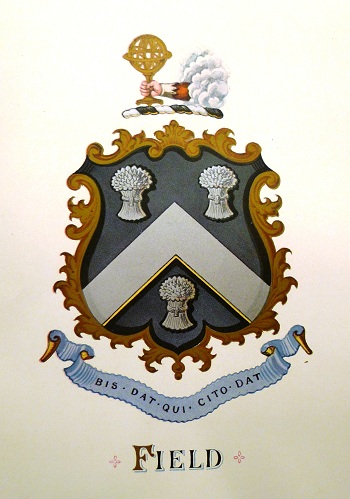 Field or Feld
Field or Feld
(Ardestow, co. York; confirmed to John Field, of East Ardsley, 4 Sept. 1558).
Coat of arms: “Sable a chevron engrailed between three garbs Or.”
Crest: “A dexter arm issuing out of clouds fesseways Proper habited Gules holding in the hand also proper a sphere Or.”
John Field was an early English astronomer, which explains the crest. He was known as the Proto-Copernicum for introducing the controversial theories of Nicholas Copernicus to England. There are several Field families listed with the same arms, including one “of Horton, Shipley and Ardsley, Co. York, and Bayside and Flushing, New York; confirmed to John Field, of East Ardsley, 4 Sept. 1558.”
One problem: the chevron in the image is not engrailed. The family pedigree written by William Field says the arms belong to “Fields of Sowerby.” The earliest listed ancestor is Roger del Feld (13c). His great-great grandson was Richard del Feld (d. ca. 1454) who was Greave of Sowerby, and his sonJohn (d. 1468) was Constable, both positions which would be held by later descendants. Robert Feild (note spelling, 1605-1673) came to the colonies, becoming a patentee in New York in 1645. The bold execution of the shield is marred by the chevron being too big and crowding the three sheaves of wheat.
Field, W. "Field Registration of Pedigree." The NYG&B Record, Vol. XLII, No. 3 (July 1911): 205, and the arms appear separately in Vol. XLIV, No. 3 ( July 1913): opposite 240.
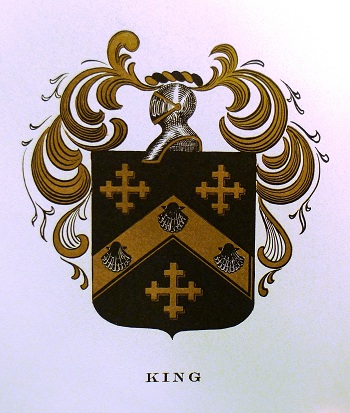 King
King
(London; granted by William Camden, Clarenceux King of Arms, who also wrote the first topographical survey of Britain and Ireland)
Coat of arms: “Sable on a chevron between three crosses crosslet or as many escallops of the field.”
Crest (not shown): “A dexter arm embowed in armour holding a broken spear all Proper.”
George Austin Morrison Jr. wrote a very detailed two-part piece on the many King arms, and the art was printed with the first. Many black and white images accompanied his article indicating frequent inclusion of escallops and crosses crosslet.
These particular arms, in Morrison's opinion, could legitimately be used by descendants of one particular King family in Jamaica, New York.
This beautifully rendered coat of arms would have been much better had the subpar torse, helm, and mantling been eliminated ... as the crest inexplicably was.
Morrison, Jr., George Austin. "The King Heraldry." The NYG&B Record, Vol. XLI, No. 4 (October 1910): 264-275.
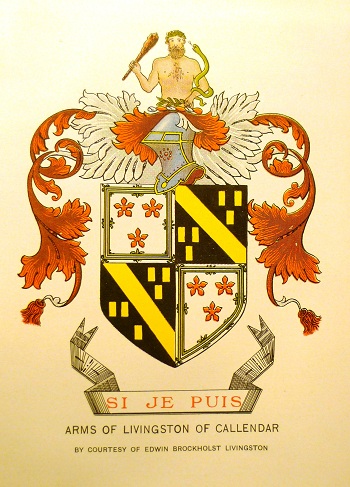 Livingston
Livingston
This appears to be some Scottish heraldic theft. The color plate for the Livingston arms appears in the Collection of the New York Genealogical & Biographical Society, Vol. 1 facing page 36. Gilbert Motier Plympton submitted the Livingston family pedigree.
The arms, Livingston quartering Callendar, are those registered by the Earl of Linlithgow in the 1672-7 period, when all Scots arms were required to be registered, minus an escutcheon of pretence and with the exception of the cinquefoils (here) for gillyflowers (as registered). Most Livingston arms use the gillyflowers, but Livingston of Counteswells and Livingston-Macdonald of Flodigarry use cinquefoils.
The blazon of the coat would be “Quarterly, 1st and 4th, Argent three cinquefoils Gules within a double tressure flory counter-flory Vert (for Livingston); 2nd and 3rd, Sable, a bend between six billets Or (for Callendar).”
The earliest ancestor was a Rev. Alexander Livingston, Resident Rector at Monyabroch, Scotland. His grandson was Rev. John Livingston, the last to die in Scotland, doing so in 1672, as his son, Robert Livingston (1654-1728), emigrated and became a Secretary to the Commissioner of Indian Affairs. None registered arms. The connection to the armiger is unproven. The lower three billets in the third quarter are not arranged symmetrically, a problem that could have been resolved with a thinner bend and a shield shape with a bit more bottom.
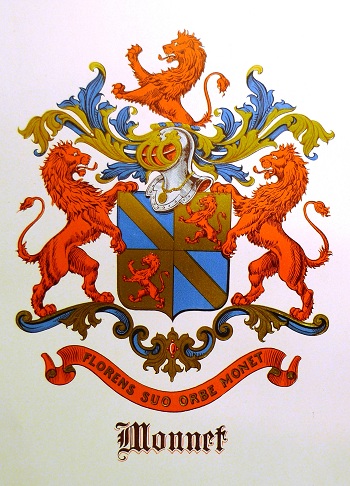 Monnet
Monnet
Origin is uncertain.
Coat: Quarterly, 1st and 4th Azure a bend Or, 2nd and 3rd Or a lion rampant Gules.
Crest: a demi-lion rampant Gules.
The Monnet pedigree was submitted by Orra Eugene Monnet. The immigrant ancestor was Isaac Monnet reportedly born about 1670 at or near Poitiers, France, and died after 1740 at "the Cliffts" in Calvert County, Maryland.
He was a Huguenot who had fled at the Revocation of the Edict of Nantes. He emigrated in 1707. Orra Monnet was an officer or member of many ancestral societies. This is a striking depicting of arms containing bold, red lions. The supporters are well drawn but appear a bit too big for the shield.
Monnet, Orra Eugene. "Monnet Register of Pedigree.” The NYG&B Record, Vol. XLVI, No. 3 (July 1915): 304, and the arms appear separately in Vol. XLVII, No. 3 (July 1916) after 312.
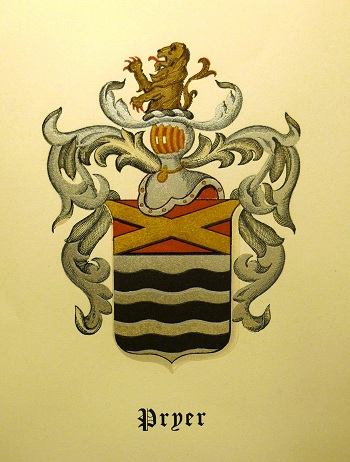 Pryer
Pryer
(High Elms, Baldock, Co. Hertfordshire)
Coat of arms: “Argent three bars wavy sable on a chief gules a saltire or.”
Crest: “A demi-lion rampant.”
The author of the article accompanying the Pryer arms is a descendant, Charles Pryer, who asserts that the arms were granted and traces the family to Armond Pryoeur de Houghton, an officer in the French Army under the Duc d'Anjou. It was Armond's great grandson Andrew Pryer (1669-1698) who immigrated to the colonies.
The coat of arms is very nicely rendered, a bold display of a simple and effective design. However, the remainder of the achievement is flat and appears almost as a rough draft.
Pryer, Charles. "Pryer Family Coat-of-Arms." The NYG&B Record, Vol. XLI, No. 4 (October 1910): 295-99.
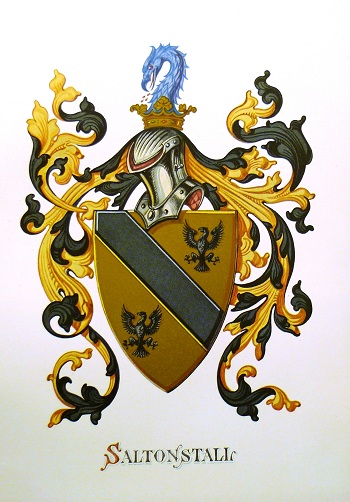 Saltonstall or Saltonson
Saltonstall or Saltonson
(Lord Mayor of London 1597, and Co. York)
Coat of arms: “Or (another, Argent) a bend between two eagles displayed Sable.”
Crest: “Out of a ducal coronet or a pelican’s head azure vulning its breast gules.”
John Reynolds Totten submitted a pedigree which identified the earliest known ancestor as Gilbert Saltenstall (16th century), father of Richard Saltonstall, Lord Mayor of London, and of Samuel Saltonstall whose son Sir Richard came to the New World in 1630 as part of the Massachusetts Bay Company. Sir Richard returned to England, but his son, the Hon. Richard Saltonstall, returned with family. Hon. Richard's son, Gurdon (1666-1734) became Governor or Connecticut in 1708 and held the position until his death. Other Saltonstalls had major roles in colonial history. Sir Samuel Saltonstall, another son of the Lord Mayor, was with the Virginia Company and named by Captain Smith as executor to his will. Overall, this is a very fine rendering of arms, but the splayed eagles on the shield are too small due to space constraints that could have been corrected by having a thinner bend. Notice the choice of the helm and compare it to the shape of the pelican’s head in the crest; the similarity of shape of the two makes a visually pleasing combination.
Totten, John Reynolds. "Saltonstall Regsiter of Pedigrees." The NYG&B Record, Vol. XLII, No. 3 (July 1911): 213-214, continued, with arms appearing Vol. XLV, No. 3 (July 1914): opposite 239.
Further information provided from Bolton, Charles Knowlton. The Founders. Boston: The Boston Athenaeum, 1919.
 Sands, Sandys or Sandes
Sands, Sandys or Sandes
(Wilberton, Isle of Ely, South Petherton, Co. Somerset, Petersham, Co. Surrey, and Co. Westmoreland)
Coat of arms: “Or a fess indented (another, dancety) between three crosses crosslet fitchy Gules.”
Crest: “A griffin sejant per fess Or and Gules.”
These arms appear with a family pedigree of James Thomas Sands. He reports the earliest American ancestor was George Sandys, a great grandson of Robert Sandys, of Rattenby.
A 19thcentury shield design makes an appearance here and, with only Or (Gold)and Gules (Red) appearing in the coat and crest, makes for very ‘hot’ arms.
Sands, James Thomas. "Sandys Registration of Pedigree.” The NYG&B Record, Vol. XLIII, No. 3 (July 1912): 293.
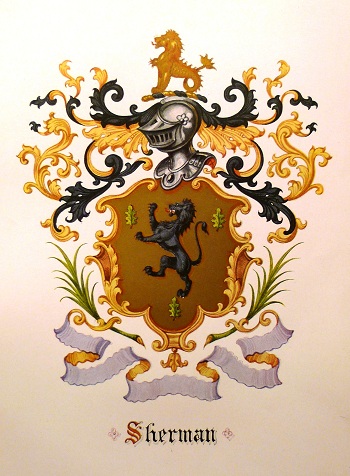 Sherman
Sherman
(Ottery St. Mary, Co. Devon; John Sherman and Richard Sherman, Visitation of Devon, 1620, sons of William Sherman and grandsons of John Sherman, who was son and heir of Robert Sherman, of Yaxley, Co. Suffolk, by his wife, the daughter of William Sherman, of Ottery St. Mary)
Coat of arms: “Or a lion rampant sable between three holly leaves vert.”
Crest: “A sea lion sejant sable goutty d’or finned proper.”
Thomas Townsend Sherman submitted his family pedigree identifying the earliest ancestor as Thomas Sherman (d. 1493). The ancestor who came to America was Capt. John Sherman (1615-1691) who settled in Watertown, Massachusetts, who is listed as having been a Steward at Harvard College in 1662.
The plant life below the shield makes an unwelcome return, and we can’t decide if the artist forgot the motto or just added a decorative blank scroll.
Sherman, Thomas Townsend. "Sherman Regsiter of Pedigrees." The NYG&B Record, Vol. XLII, No. 3 (July 1911): 208, and arms appear later in Vol. XLIV, No. 4 (Oct. 1913): opposite 341.
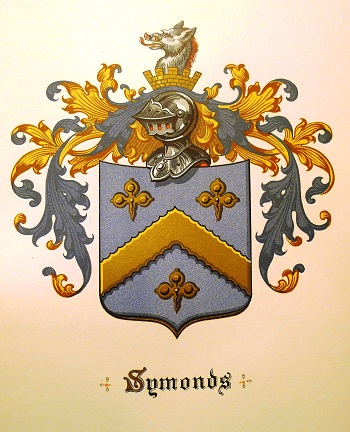 Symonds
Symonds
(Co. Essex)
Coat of arms: “Azure a chevron engrailed between three trefoils slipped or.”
Crest: “Out of a mural coronet chequy argent and azure a boar’s head of the first crined sable.”
Motto: “Moriendo vive.”
The arms here has a slight difference; the crown coronet is Or. And while the color is attractive, the shield is more gray than blue. Mary Louise Woodin reports that the arms were granted by a letter patent of 10 January 1625 but fails to say to whom. The use of the blue-gray isn’t unattractive.
Woodin, Mary Louise. "Symonds Registration of Pedigree.” The NYG&B Record, Vol. XLII, No. 1 (April, 1912): 96-97, arms printed in No.3 (July 1912): after 288.
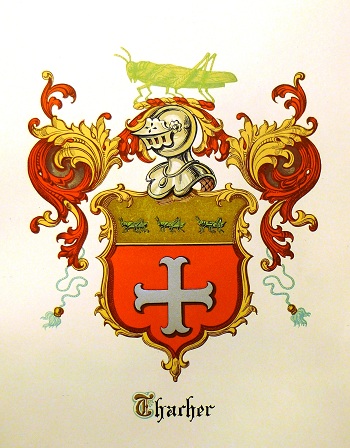 Thacher or Thatcher
Thacher or Thatcher
(Co. Essex)
Coat of arms: “Gules a cross moline argent on a chief or three grasshoppers proper.”
Crest: “A Saxon sword or seax proper.”
The first item that will be noticed is that the crest in the art differs from Burke's. America Heraldica mentions both crests. Author John R. Totten, then Record editor, notes that some English families also used three birds volant Azure in the chief. The arms in the art were used in a seal impressed in wax on a letter dated 16 August 1676 from Rev. Thomas Thacher, pastor of the Old South Church, Boston, to his son in London. The American Thachers descend from Rev. Peter Thacher of Queen Canal, Co. Somerset. His widow's will includes a seal with these arms which includes the grasshopper crest.
Totten writes "it is not ... for a moment to be supposed that Rev. Thomas Thacer [sic], one of the leading divines of his day, and also one of the most prominent men of Boston, would have presumed to transgress the law in using such armorial insignia. The fact that he possessed this seal and used it is the strongest presumptive proof of his legal right to do so." Well, maybe. The three grasshoppers in the chief and the cross in the main portion of the shield are drawn out of balance in our opinion. Much space is wasted.
Totten, John R. "Thacer-Thatcher Coat-of-Arms." The NYG&B Record, Vol. XLI, No. 2 (April 1910).
 Tromper
Tromper
(Rotterdam)
Coat of arms: “D’argent a la fasce d’or; a quatre ailes de moulin au naturel posées en sauterne et réunies par une macle de sable brisées sur le tout.”
This is from Rietstap’s Armorial Général. Translation by John Shannon: “Argent over a fess Or four windmill sails in saltire Proper gathered in a mascle Sable.” This is the left (dexter) of the two shields. Louis P. DeBoer provides a listing of Tromper ancestors, the earliest being Pieter Tromper (15th century). For generations, the family had leading roles in Rotterdam. The ancestor who came to America was probably Jacob Tromper. Attribution of arms is not made. The Van Driel arms apparently come into the family through Cornelia Claes Van Driel who married Adriaen Pietersz Tromper in 1626. We end with one of the better renderings.
De Boer, Louis P. “The Tromper Family of Rotterdam in the Netherlands.” The NYG&B Record, Vol. XLV, No. 3 (July 1914): 218-225) .
© 2011 The New York Genealogical and Biographical Society.
All rights reserved.